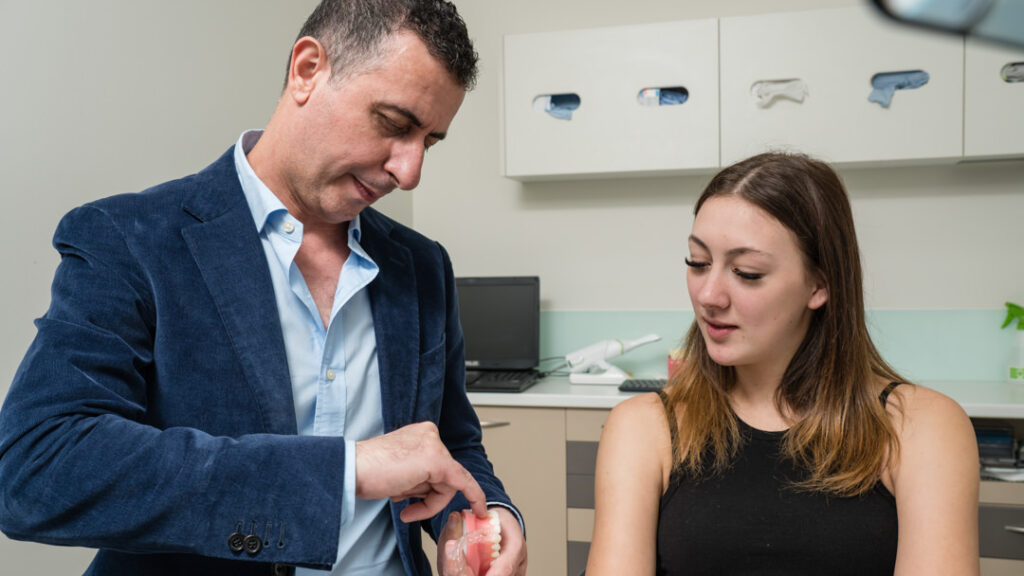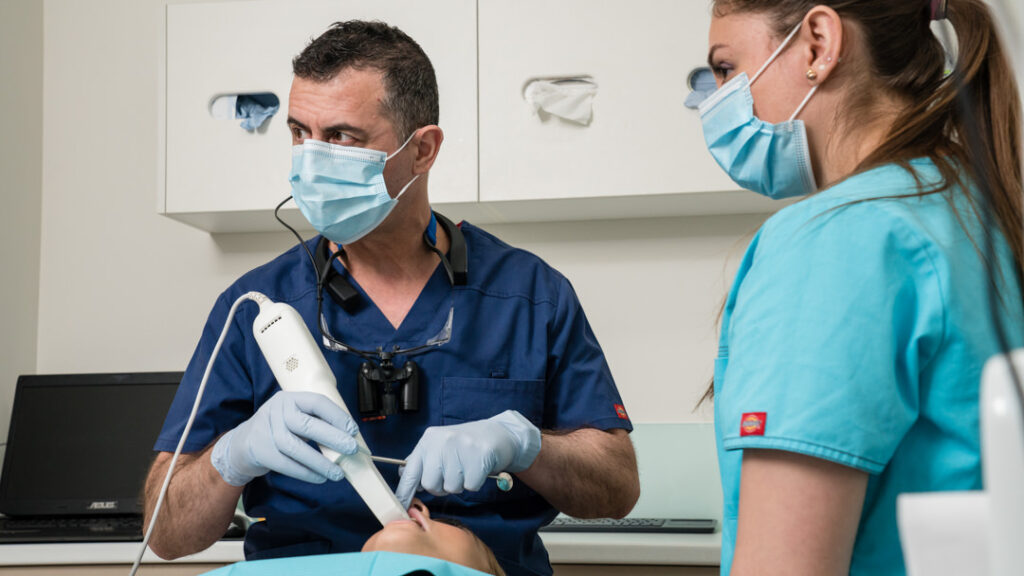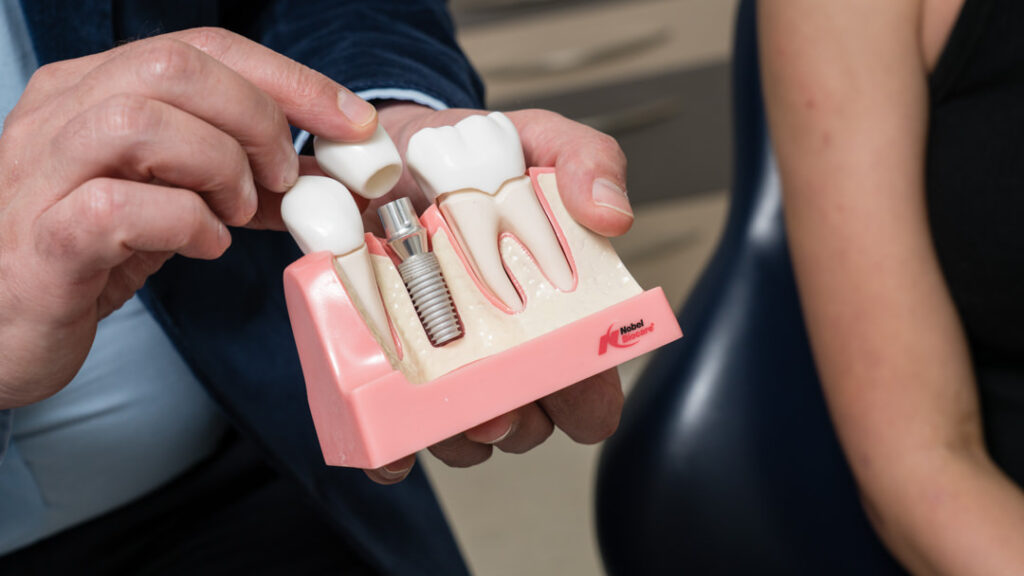
Types of Dental Implants
Dental implants have revolutionized the field of dentistry, offering a long-lasting and natural-looking solution for missing teeth. They are titanium posts surgically inserted into the jawbone to act as artificial tooth roots.
However, not all dental implants are the same. There are different types available, each designed to cater to specific needs and circumstances. These types of dental implants vary in size, shape, and placement technique, allowing dentists to customize treatment plans for individual patients.
Some common types include:
- Endosteal implants: These are inserted directly into the jawbone and are the most commonly used type of dental implant. They are typically shaped like small screws or cylinders and provide a stable foundation for single or multiple artificial teeth.
- Subperiosteal implants: Unlike endosteal implants, subperiosteal implants sit on top of the jawbone, beneath the gum tissue. They are suitable for patients who do not have enough healthy jawbone to support traditional implants. Subperiosteal implants consist of a metal framework that attaches to the jawbone, with posts protruding through the gums to hold artificial teeth.
- Zygomatic implants: These implants are specifically designed for patients with inadequate jawbone structure. Instead of being placed directly into the jawbone, zygomatic implants are anchored in the cheekbone (zygomatic bone). This alternative approach provides a stable foundation for dental restorations, even when there is minimal jawbone available.
Understanding these different types of dental implants can help patients and dentists make informed decisions about the most suitable treatment option for their unique situations.
Dental Implant Procedure
The dental implant procedure involves a series of steps to replace a missing tooth with an artificial implant. Dental implants are a popular and effective solution for those who have lost a tooth due to injury, decay, or other dental issues. This procedure offers a long-lasting and natural-looking solution that can restore both the function and aesthetics of a patient’s smile.
The dental implant procedure typically begins with a comprehensive examination and consultation with a qualified dentist or oral surgeon. This initial step is crucial to assess the patient’s oral health, bone density, and overall suitability for the implant procedure. X-rays and other imaging techniques may be used to determine the precise location and angle for the implant placement.
Once the patient is deemed suitable for dental implants, the next step is the surgical placement of the implant. This involves the insertion of a titanium post into the jawbone, acting as a replacement for the tooth root. The implant is then left to fuse with the bone through a process called osseointegration, which typically takes several months.
After the implant has successfully integrated with the jawbone, an abutment is placed on top of the post. This abutment serves as a connector between the implant and the artificial tooth or crown. Impressions are then taken to create a custom-made crown that matches the patient’s natural teeth in color, shape, and size.
Finally, the crown is attached to the abutment, completing the dental implant procedure. The result is a fully functional and aesthetically pleasing replacement tooth that blends seamlessly with the patient’s natural smile.
Specific Types of Dental Implants
When it comes to specific types of dental implants, there are several options available. Endosteal implants are the most common type, which are placed directly into the jawbone. Subperiosteal implants are placed on top of the jawbone, under the gum tissue. Zygomatic implants are used when there is insufficient bone in the upper jaw. Mini dental implants are smaller in size and can be used for patients with less bone density. All 4 dental implants provide a full arch replacement with just four implants.
Endosteal Implants
Endosteal implants are a widely used dental implant technique that involves surgically placing a titanium post into the jawbone. This type of dental implant is considered the most common and effective method for replacing a missing tooth. Endosteal implants are suitable for patients with sufficient bone density in the jawbone to support the implant.
The procedure begins with the placement of the titanium post into the jawbone, which serves as a sturdy foundation for the artificial tooth. Once the implant has integrated with the surrounding bone, a dental crown is placed on top, providing a natural-looking and functional replacement tooth.
Endosteal implants offer a long-lasting solution for individuals seeking to restore their smile and improve their oral health.
Subperiosteal Implants
Another type of dental implant that offers an alternative solution for patients with inadequate jawbone density is known as a subperiosteal implant. Unlike endosteal implants, which are placed within the jawbone, subperiosteal implants are placed on top of the bone, just below the gum line.
These implants consist of a metal framework that is custom-made to fit the shape of the patient’s jawbone. The framework has posts or attachments that protrude through the gums, allowing the replacement teeth to be securely attached.
Subperiosteal implants are an ideal option for patients who have significant bone loss and are unable to undergo bone grafting procedures. This type of dental implant provides stability and support for replacement teeth, restoring the patient’s ability to speak and chew properly.
Zygomatic Implants
Zygomatic implants offer a specialized solution for patients with severe bone loss in the upper jaw. When traditional dental implants cannot be used due to inadequate bone density, zygomatic implants provide an alternative option. These implants are longer and anchor into the zygomatic bone, also known as the cheekbone, providing stability to support dental restorations.
Zygomatic implants are suitable for individuals who have missing teeth in the upper jaw and have experienced significant bone loss. By utilizing the zygomatic bone, which typically remains unaffected by bone loss, these implants ensure a stable and secure foundation for dental prosthetics.
With zygomatic implants, individuals can regain function and aesthetics, improving their quality of life and confidence.
Mini Dental Implants
Mini dental implants are a popular choice among patients seeking a less invasive option for tooth replacement. These dental implants are smaller in diameter compared to traditional implants, typically ranging from 1.8mm to 3.3mm. They are used to stabilize dentures, bridges, or crowns in patients with limited bone structure or who prefer a less invasive procedure.
Mini dental implants offer several advantages. First, they require less bone volume for successful placement, making them suitable for patients with inadequate bone density. Additionally, their smaller size allows for minimally invasive surgery, reducing discomfort and healing time. Mini dental implants also provide a more affordable alternative to traditional implants.
Despite their smaller size, mini dental implants offer excellent stability and durability, allowing patients to enjoy restored dental function and aesthetics. However, it is important to note that not all cases are suitable for mini dental implants. Consulting with a dental professional is essential to determine the best treatment option for each patient’s specific needs.
All on 4 Dental Implants
All on 4 dental implants offer a comprehensive solution for patients seeking a stable and permanent option for full arch tooth replacement. Unlike traditional dental implants that require individual implant placement for each missing tooth, All on 4 implants support a full arch of teeth with only four implants per arch.
This innovative technique is suitable for patients with reduced bone density, as it maximizes the use of available bone by angling the implants strategically. By distributing the forces evenly across the implants, All on 4 implants provide excellent stability and functionality.
This type of dental implant offers numerous advantages, including reduced treatment time and cost, improved oral hygiene, and enhanced aesthetics. Patients considering full arch tooth replacement should consult with their dentist to determine if All on 4 dental implants are the right option for them.
Bone grafting for dental implants
Bone grafting is a crucial procedure for dental implants, as it provides the necessary foundation and support for successful implant placement. When a patient lacks sufficient bone density in the jaw to support an implant, bone grafting is often recommended to create a stable base. This procedure involves taking bone from another part of the body, such as the hip or chin, or using synthetic bone material, and grafting it onto the jawbone.
The main purpose of bone grafting is to stimulate the growth of new bone cells in the grafted area. This process allows the jawbone to become stronger and denser, providing a solid foundation for the dental implant. The success of the implant depends on the integration of the graft with the existing bone, which can take several months to occur.
During the bone grafting procedure, the dentist or oral surgeon will make an incision in the gum tissue to expose the underlying jawbone. The graft material is then placed in the deficient area and secured with screws or stitches. Over time, the graft will fuse with the existing bone, creating a strong and stable base for the implant.
It is important to note that not all patients require bone grafting for dental implants. Factors such as bone density and the location of the missing tooth or teeth will determine whether or not a bone graft is necessary. A thorough examination and consultation with a dental professional will help determine the best course of action for each case.
Implant-Supported Bridge and Denture
Implant-supported bridges and dentures offer a reliable and long-term solution for individuals who have multiple missing teeth. Dental implants are used to anchor and support these prosthetic restorations, providing stability and functionality that is similar to natural teeth.
Implant-supported bridges are designed to replace multiple missing teeth by attaching a custom-made bridge to dental implants. The implants act as artificial tooth roots, securely holding the bridge in place. This type of restoration not only restores the appearance of a complete smile but also maintains proper chewing function and prevents the surrounding teeth from shifting.
Implant-supported dentures, on the other hand, are used when all of the teeth in an arch are missing. These dentures are attached to dental implants, providing better stability compared to traditional removable dentures. Implant-supported dentures can be either fixed or removable, depending on the patient’s needs and preferences. Fixed implant-supported dentures are permanently attached to the implants and can only be removed by a dentist, while removable implant-supported dentures can be taken out for cleaning.
When considering implant-supported bridges or dentures, it is important to have sufficient bone density in the jaw to support the dental implants. If the bone density is inadequate, bone grafting may be necessary to strengthen and regenerate the jawbone. This procedure involves adding bone graft material to the affected area, allowing for successful implant placement.
Implant-supported bridges and dentures are highly effective solutions for individuals with multiple missing teeth. With proper care and maintenance, these restorations can provide a long-lasting and natural-looking smile, improving both aesthetics and oral function.
Risks and Complications of Dental Implants on Tooth and Gum
One important consideration when undergoing dental implant surgery is understanding the potential risks and complications involved. While dental implants are generally safe and have a high success rate, it is important to be aware of the possible complications that can arise.
One of the main risks is infection. Like any surgical procedure, there is a risk of infection at the implant site. This can occur during or after the surgery and may require treatment with antibiotics.
Another potential complication is damage to surrounding structures. During the implant placement, nearby nerves, blood vessels, or sinuses can be affected, leading to numbness, tingling, or pain. However, this is rare and can often be avoided with proper planning and imaging.
Another risk is implant failure. Factors such as poor oral hygiene, smoking, or certain medical conditions can increase the risk of implant failure. Additionally, if the bone density is insufficient to support the implant, it may not integrate properly and could eventually become loose or fail. Your dentist will evaluate your bone density before proceeding with the implant surgery.
Complications can also arise with the gums surrounding the implant. If the gums are not properly cared for, they can become inflamed, leading to a condition called peri-implantitis. This can cause the implant to become loose and potentially fail. Regular dental check-ups and good oral hygiene practices are crucial for preventing this complication.
Conclusion
In conclusion, dental implants are a reliable and effective solution for replacing missing teeth. The procedure involves the placement of a titanium implant in the jawbone, which acts as a root for the replacement tooth. Different types of dental implants are available to cater to specific needs and requirements. Bone grafting may be necessary in cases where there is insufficient bone density. Despite potential risks and complications, dental implants offer long-term benefits and improved oral health



